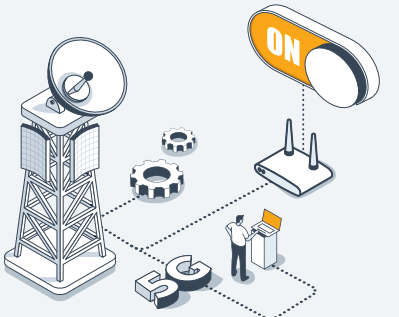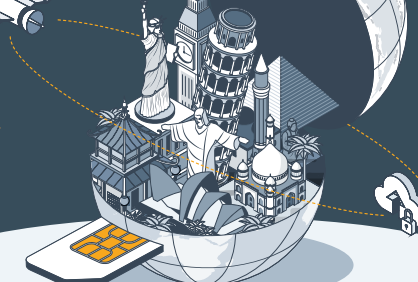As volumes of connected devices grow, and device manufacturers and OEMs expand their business operations overseas, simplified access to global connectivity is a must. IoT service providers and mobile network operators need to take new approaches to support the global nature of their enterprise customers’ business, by providing them access to seamless, simplified global connectivity. The IoT service providers need to be able to ensure devices have access to optimised connectivity wherever they are deployed while also maintaining compliance with local and vertical industry regulations. Mobile operators also need ways to serve their global customers in markets where they don’t have capacity. Both types of organisations need a new approach to IoT connectivity and simplified, automated ways to manage connections at scale.
With its global core infrastructure located in data centres across the world, floLIVE operates a hyper-local data network based on an array of interconnected local core mobile networks from which it provides centrally managed local connectivity for any device in any location. The network has been designed to comply with privacy laws, data regulations and roaming restrictions enabling floLIVE to offer low latency, high performance, fully compliant connectivity. The floLIVE connectivity management platform (CMP) enables module makers, device OEMs and IoT organisations to control their connectivity in the same way a carrier does. Users can monitor their devices, access real-time network events and usage, change operators remotely and predictively troubleshoot failures.
The need to manage mega-volumes of global connections flexibly and at huge scale is being addressed by the simplifications new SIM variants bring to the supply chain. However, the connectivity now needs to offer the same flexibility, performance and ease of management, Rony Cohen, the co-founder and head of business development at floLIVE, tells George Malim, the managing editor of IoT Now. Cohen is an experienced telecoms industry executive and serial entrepreneur who has held senior positions in established multinational firms and has founded several successful mobile phone and M2M-related businesses. His previous positions include serving as chief executive of Marathon Telecom, as director of 018 Xfone, and telecom director at Equator Investments. He holds a degree from the European Business School.

George Malim: What impacts do you expect the arrival of eSIM and iSIM to have on IoT connectivity? Big promises are being made about improved flexibility and operational efficiency but how will IoT service providers be able to unlock these?
Rony Cohen: First of all, we welcome new advances in SIM technologies. Mass IoT will only be available and deployed if we move away from plastic SIMs. There is no space for shipping billions of plastic SIM cards around the world anymore. This only causes delays and incurs additional costs, not to mention the negative environmental impact. Mass IoT will only be achieved with embedded or even integrated SIMs and there is significant potential for electronic or surface-mounted SIMs to simplify SIM-enabled connectivity.
From our point of view, when Apple announced the iPhone14 which has no plastic SIM capability and mandates usage of eSIM, it took the industry to a new place. In this new reality, roaming is slowly becoming defunct. With eSIM capabilities, operators can’t force users to utilise a roaming SIM because they have access to an embedded universal integrated circuit card (eUICC) eSIM. This means users can simply scan a QR code and connect to a local service, there’s no reason for them to roam. This is forcing operators to admit roaming is dead and pushing the consumer market towards the same model as the IoT space.
There is another element to the introduction of iSIM for IoT use cases – size. While the motivation for moving towards iSIM is reduced footprint in terms of size, memory and power consumption, the GSMA eUICC standard requires exactly the opposite – a large size SIM, strong processing power and a large data payload when downloading new profiles to a device. So for IoT use cases, the highly efficient multi-IMSI technology is the way to go.
GM: The ability to access local connectivity for devices easily is central to the eSIM and iSIM business case. Do you think the IoT market is aware and ready for the concept of localised connectivity?
RC: Until now, we have had two models of operation. The industry has the traditional model where an enterprise tries to buy a SIM card from a phone company and gets it shipped back to a factory for installing into devices. The alternative has been to buy country-specific SIMs from an aggregator that either ships multiple different SIMs to the factory or offers roaming SIMs in the same way. A third possibility, of having SIM cards installed into devices locally before deployment, becomes increasingly unviable as volumes increase.
For IoT use cases, roaming has severe limitations. These range from the growing list of countries that don’t allow permanent roaming, to situations in which the roaming deals that an aggregator provides don’t necessarily deliver the optimum connectivity for a specific application in a specific location. There can be gaps in coverage, poor performance, or high latency, all of which can be catastrophic to IoT use cases, and none of which occur with local connectivity.
The old way of doing things also has substantial administration and management required which is increasingly unsustainable for mass-scale IoT. IoT is a global business, and the headache of managing multiple operator relationships, each with different billing cycles, service level agreements (SLAs) and contracts is prohibitively resource intensive.
Awareness of this reality is growing and as an industry, we now understand the problems of scale that roaming faces. Permanent roaming, in markets where it is legal, was not included in operators’ network design plans. For the first time, mobile operators are struggling to manage and accommodate roaming. A large operator, for example, might have 35 million subscribers and therefore has built its roaming network to accommodate maybe one million roaming subscribers. If it suddenly needs to support ten million IoT devices via roaming connections, it is physically not going to work. Localised connectivity is the natural solution.
The second aspect here is the commercial perspective. Mass IoT connectivity contracts are typically for five or ten years. This works well for battery-powered devices with consistent needs and low power consumption. The low power wide area (LPWA) network technologies offer flexibility to suit use cases such as battery-operated trackers but the frequency and size of communication substantially affects cost. On the other hand, devices that have greater network demands, less predictable usage and shorter lifespans don’t find the constraints of a five-year contract appealing. When you have billions of devices that all demand a minimum level of performance and this is what customers are paying for, performance becomes the key issue at hyperscale.

GM: What role does floLIVE play in the continuing move towards IoT connectivity maturity?
RC: These are exactly the challenges we were aligned with when we founded floLIVE. We understood the need to own the core network and the entire technology stack, and we were sure about the demand to receive it as-a-service both for IoT service providers and mobile network operators (MNOs). We had a strong vision which was lacking in the industry at the time.
I said to customers in 2015, when we launched the company, that IoT is global but mobile network operators are local. That has resulted in global IoT products and devices but the need for mobile virtual network operators (MVNOs) to commercialise local connectivity. Achieving that is going to happen within our technology and the way we solve the challenge is by customers taking the technology we provide as-a-service.
When we provide this as-a-service we utilise the infrastructure we have built in the local data centres of core networks all over the world. This is the only large-scale, global infrastructure for IoT that anyone has ever built. We are tremendously proud of what we’ve achieved. Over a dozen core networks globally distributed and additional packet gateways in large countries. This enables us to offer 2G, 3G, 4G, NB-IoT, CAT-M and 5G coverage in all locations, and to be ready for the connectivity technologies of tomorrow, too.
We’ve done this by working with mobile operator groups that have a large footprint. We have several partnerships that can provide local international mobile subscriber identifications (IMSIs), local IP addresses and low latency services.
GM: How do you handle privacy and compliance mandates?
RC: By having local infrastructure, our services are compliant with General Data Protection Regulations (GDPR) and privacy laws and ensure compliance with data sovereignty requirements. This is particularly important in regulated industries where sometimes companies have no interest in sending data across networks via roaming and in some cases would be in breach of relevant regulations if they did. For example, financial service providers in Europe are not allowed to move transaction data across national boundaries.
Our core infrastructure enables the protection of our customers’ data and achieves compliance while also solving the issue of permanent roaming. Mobile operators are already using our infrastructure to enable hyperscale IoT networks without the need for roaming. We see the addition of satellite networks to our global IMSI library as another network to provide complementary connectivity in rural areas that are not covered by national mobile operators. In low-earth orbit (LEO) networks as with narrowband IoT (NB-IoT), the SIM needs to be authenticated, and the way to do that is with a core network. We’ve signed up two satellite operators so far and a third is on the way and these are being used to fill gaps in coverage, further strengthening our comprehensive global connectivity.
GM: Hyperscale volumes demand total automation, yet IoT service providers still need to be in control of their connectivity. How are connectivity management platforms (CMPs) enabling visibility?
RC: Enterprises can support themselves, as long as they have full visibility and control over their connected assets. Most CMPs are largely similar to one another, relying on legacy technologies; furthermore, implementing these CMPs requires long integration cycles with other systems and platforms. This leads to significant time-to-market, raised overall cost and poor ability to meet SLAs.
The main difference with our CMP is that it’s cloud-based, holistic and provided as a service to both IoT service providers and mobile operators. When I say ‘holistic’ I mean that our CMP comprises all necessary building blocks, all designed and built on the same, modern software technology and highly flexible to accommodate the specific needs of our customers. Having a single vendor that can take responsibility over the service and support of the entire platform means service providers can commit to much more aggressive SLAs towards their customers, as well as reduce their operational costs by offering advanced self-service capabilities to their customers.
But there is another aspect – it’s no secret that most mobile operators are still struggling in turning their IoT business profitable – there is a paradox between the huge number of connected devices and the ability to monetise this business. This is mainly due to mobile operators relying on these legacy technologies and trapped by the high operational costs. However, when you move to the cloud, the economies-of-scale start working in your favour. With floLIVE, mobile operators don’t have to invest heavily in capex and can start small and gradually expand as their business grows. A holistic platform also helps cut down the costs of other necessary systems such as core networks and billing.
The difference between us and anyone else is that we’re an infrastructure company and connectivity is an application layer that we provide. We provide a CMP for mobile operators as well as to IoT service providers. As service providers are given the whole platform out-of-the-box, they can immediately start selling connectivity. We include the global operator coverage, the real-time visibility, the business support suite, and the SIM manageability. That single SIM is all that the business needs to hit the ground running.
GM: What are the benefits for mobile operators?
RC: If I were to lay out the main benefits for mobile operators, the number one benefit would be profitability. This is key when any organisation decides to enter a new market or offer a new service. The second benefit, and in some cases this may be even more interesting than the first one, is our ability to generate revenue for the mobile operator. When I said earlier that IoT is global but mobile operators are local, I was referring to the fact that no mobile operator will invest in sales and marketing efforts overseas to attract customers. However, floLIVE is very well positioned to bring in new connectivity revenues from our existing and growing number of global customers, and this is a game changer for many mobile operators – the ability to attract new users to consume their services, with no marketing or advertising, and no effort on their part.
Other benefits are the ability to support the many new and innovative business models that have been triggered by the many different IoT use cases, enhanced by the fact that we own the entire technology and do not source elements from other parties. Indirectly, the fact that our platform allows customers access to every network or billing event in real-time, reduces the load off the mobile operators’ support organisations, leading to further reduction in operational costs and increased customer satisfaction.
Altogether, we’re running this global, cloud-based service that keeps deployment time very short and operators can use it to provide their customers with connectivity overseas. They can continue to serve their customers cost-effectively with high-performance connectivity – and do so profitably.
GM: How about for the IoT enterprises?
RC: Right now, enterprises need to be able to manage their device connectivity more efficiently. Imagine calling an operator support centre and trying to explain that you have an issue with a connected vending machine in Tanzania. They effectively have no control over these devices and no way to find out what is happening with it.
With us, the app goes on top of the global infrastructure we have built so our customers have a user interface that tells them whether the device is connected, the performance it is receiving, its up-to-date data usage and much more. This takes away the complexity and replaces it with usable, valuable data. I see this as an equivalent to the AWS model but for IoT connectivity.
Our approach also opens new business models for many kinds of IoT enterprises. Not only can enterprises use it for their own devices, they can start reselling connectivity and immediately open new revenue streams. Connectivity used to be far too complex to be offered by resellers, involving its own core competencies and relying on businesses creating relationships with multiple operators in various regions. Now, resellers can own their own connectivity via our CMP, and take control and visibility, handing that over to their own end users. Our platform is multi-multi, multi-tenant, multi-tier, and multi-network. As a result, enterprises can adopt a turnkey model to start reselling connectivity.
GM: What makes floLIVE different to other providers?
RC: Our uniqueness lies in our hyperlocal global data network. This network is the first and largest of its kind in the world today, connecting mobile operators and IoT service providers from all over the world – a carrier-grade cloud-native platform that offers the same level of service, performance and SLA to all our customers globally. And all services are available and exposed via a rich REST API suite that allows any customer to consume our connectivity services anywhere in the world in exactly the same way.
When we say our platform provides a single pane of glass, we really mean it. We have recently added an important capability to our platform – M2M and consumer eUICC capabilities. This further expands our offering into a single platform that’s a one-stop-shop for all connectivity elements – core infrastructure, multi-IMSI SIM management, real-time IoT billing and eSIM RSP.
Comment on this article below or via X: @IoTNow_OR @jcIoTnow










